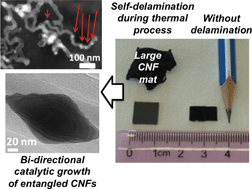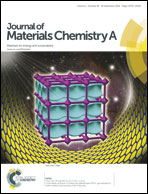Ultra high-yield one-step synthesis of conductive and superhydrophobic three-dimensional mats of carbon nanofibers via full catalysis of unconstrained thin films†
Abstract
We directly synthesized large conductive and superhydrophobic three-dimensional mats of entangled carbon nanofibers (CNFs) using thermal chemical vapor deposition (CVD). We show that the yield obtained from the catalysis of an unconstrained thin Ni–Pd film is over an order of magnitude higher compared to that of the same thin film when bound to a substrate. The growth mechanism differs from substrate-bound growth, where catalysis occurs only on the top surface of the catalytic film, as the full Ni–Pd catalyst layer participates in the reaction and is totally consumed to bi-directionally grow CNFs. Therefore, the yield further increased with the thin film thickness, in contrast to substrate-bound growth. The unconstrained growth occurred thanks to a weak adhesion layer that delaminated during the thermal process. Additionally, we showed that the supporting substrate material strongly affected the nanostructure morphology obtained. The as-grown CNF mats were used as a three-dimensional electrode for lithium-ion batteries. We envisage these CNF mats to be an ideal platform to be functionalized for multiple applications including high-performance electrodes, sensors, electromagnetic shields, and conductive polymer-coated composites.


 Please wait while we load your content...
Please wait while we load your content...